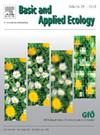土地利用与局地干扰对湿地植物和传粉昆虫群落的影响对比
IF 3.5
2区 环境科学与生态学
Q2 ECOLOGY
引用次数: 0
摘要
虽然传粉媒介和湿地都提供重要的生态系统服务(例如,开花植物的授粉和改善水质),但两者之间的关系尚不清楚。生物效应和非生物效应都可以调节当地湿地的花卉和传粉昆虫群落。在这项研究中,我们研究了土地利用如何影响湿地生态系统中的传粉昆虫,包括在250 m至2 km的五个不同半径上的土地利用梯度,以及人为干扰。我们在两年的时间里调查了15个不同湿地的植物传粉者群落的丰度和多样性。我们还测试了水质与温度之间的关系,以及开花植物和传粉昆虫的丰度和多样性。研究结果表明,温度升高对湿地植物的花卉展示,以及所有访花者和悬停蝇的数量都有负面影响,而温度升高与土地利用的发达程度密切相关。飞蝇丰度与农业用地和水体总氮呈显著正相关。同时,雌性蜜蜂的丰度受到温度和干扰的相互作用的影响:在低干扰地区,温度较低时雌性蜜蜂的丰度最高。在土地利用程度较低时,传粉媒介物种丰富度随温度升高而增加,植物多样性受干扰、土地利用和水质的多重相互作用的强烈影响。最后,植物和昆虫的群落组成在低、中、高干扰类别之间存在显著差异,杂草和非本地物种与高干扰地区和高人为土地利用地点显著相关。我们证明了生态群落对人为变化的显著响应。我们的工作还说明了量化土地利用和局部干扰与生态系统的温度和水质等非生物因素之间的相互作用的重要性。本文章由计算机程序翻译,如有差异,请以英文原文为准。
Contrasting effects of land-use and local disturbance on plant and pollinator communities in wetlands
While pollinators and wetlands both provide important ecosystem services (e.g., the pollination of flowering plants and improving water quality), the relationship between the two is not well understood. Both biotic and abiotic effects can mediate the local wetland flower and pollinator community. In this study, we investigated how land use, including a land use gradient at five different radii, from 250 m to 2 km, along with anthropogenic disturbance affected pollinators in wetland ecosystems. We surveyed the abundance and diversity of plant-pollinator communities in fifteen different wetlands across two years. We also tested the relationship between water quality and temperature, and the abundance and diversity of flowering plants and pollinating insects. Our results suggest that increasing temperature, which was strongly associated with developed land use, had a negative effect on the floral display of wetland plants, as well as the abundance of all flower visitors and hover flies. Hover fly abundance was also positively associated with agricultural land use and total nitrogen in the water. Meanwhile, the abundance of female bees was affected by an interaction between temperature and disturbance: female bees were most abundant when temperatures were lower in areas of low disturbance. In contrast, pollinator species richness increased with temperature when developed land use was low, and floral diversity was strongly affected by several interactions between disturbance, land use, and water quality. Finally, the community composition of both plants and insects varied significantly among low, medium, and high disturbance categories, with weedier, non-native species being significantly associated with areas of higher disturbance and in sites with greater anthropogenic land use. We demonstrate that ecological communities shift significantly in response to anthropogenic change. Our work also illustrates the importance of quantifying interactions between land use and local disturbance with abiotic factors such as temperature and water quality on ecological systems.
求助全文
通过发布文献求助,成功后即可免费获取论文全文。
去求助
来源期刊

Basic and Applied Ecology
环境科学-生态学
CiteScore
6.90
自引率
5.30%
发文量
103
审稿时长
10.6 weeks
期刊介绍:
Basic and Applied Ecology provides a forum in which significant advances and ideas can be rapidly communicated to a wide audience. Basic and Applied Ecology publishes original contributions, perspectives and reviews from all areas of basic and applied ecology. Ecologists from all countries are invited to publish ecological research of international interest in its pages. There is no bias with regard to taxon or geographical area.
 求助内容:
求助内容: 应助结果提醒方式:
应助结果提醒方式:


